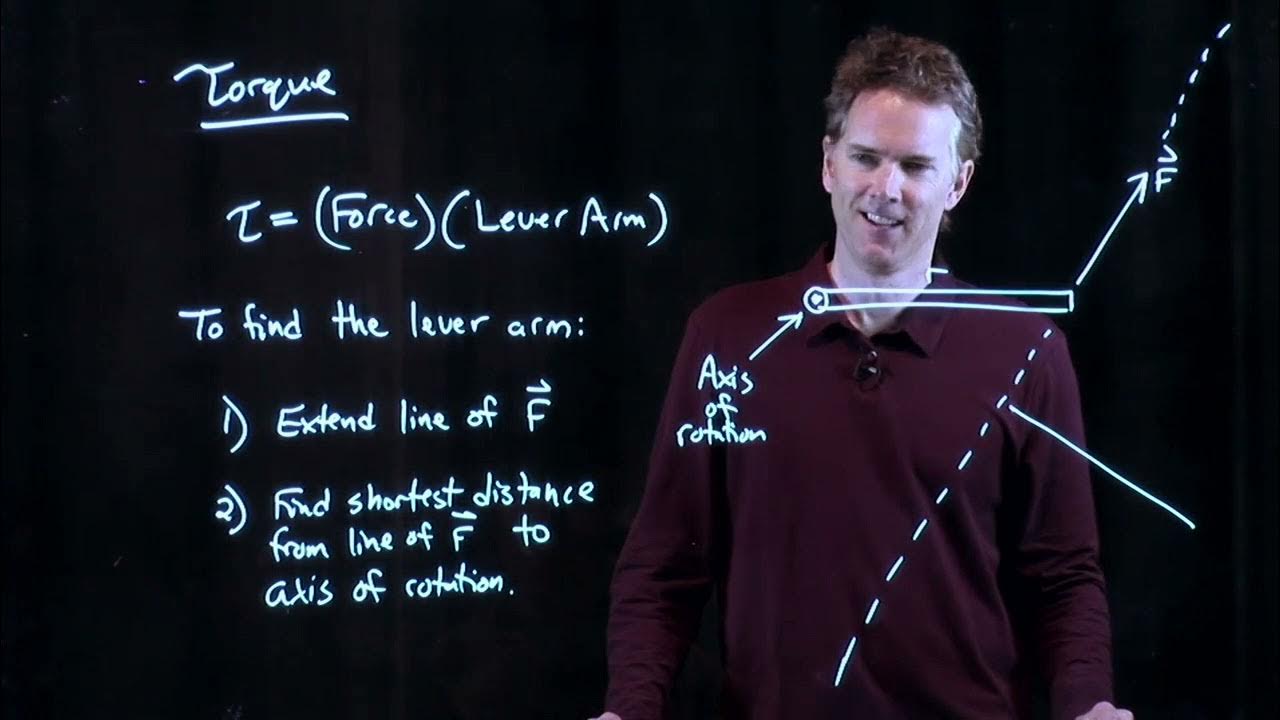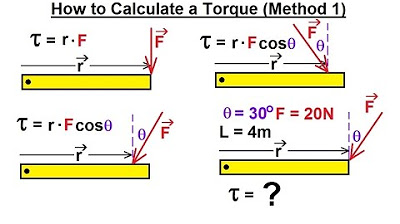Torque on a Bolt | Physics with Professor Matt Anderson | M12-10
TLDRIn this educational transcript, Professor Anderson introduces a torque problem involving the removal of a bolt. The scenario presents a wrench applied to the bolt at an angle of 105 degrees due to geometric constraints, rather than the ideal perpendicular approach. Given the bolt requires a torque of 33 Newton meters to loosen, and with a wrench length of 29 centimeters (0.29 meters), the problem is to determine the force (F) needed to apply on the wrench. The solution is derived using the torque formula, which equates torque to the product of the force, the lever arm, and the sine of the angle (phi). By substituting the given values into the formula ( F = \( \frac{\text{Torque}}{r \cdot \sin(\phi)} \) ), the calculated force required is 117.8 Newtons. This concise explanation provides a clear understanding of how to calculate the force needed in such a practical situation, encouraging students to apply their knowledge of physics to real-world problems.
Takeaways
- 🔩 The problem involves calculating the force required to loosen a bolt using a wrench.
- 📐 The wrench is not pulled at a right angle but at an angle of 105 degrees to the bolt.
- 🛠️ Torque is the key concept, defined as the force times the lever arm or the perpendicular component of the force times the radius.
- 📏 The wrench length (lever arm) is given as 29 centimeters or 0.29 meters.
- 🔢 The torque required to loosen the bolt is specified as 33 Newton meters.
- 📐 The angle at which the wrench is pulled is 105 degrees, which is greater than 90 degrees.
- ⚙️ The formula to calculate the force (f) is torque divided by the lever arm (r) times the sine of the angle (phi).
- 🧮 By substituting the given values into the formula, the force required is calculated to be 117.8 Newtons.
- 🔍 The calculation involves understanding the relationship between torque, force, and the angle of application.
- 🤔 The problem emphasizes the importance of considering the angle when calculating the force needed to apply torque.
- 👨🏫 Professor Anderson encourages students to seek further clarification if the explanation is not clear, offering help in his office.
Q & A
What is the scenario described in the problem?
-The scenario involves removing a bolt with a wrench, but the geometry requires pulling the wrench at an angle rather than directly perpendicular.
What angle is the wrench being pulled at, and how does it affect the torque calculation?
-The wrench is pulled at a 105-degree angle, which requires calculating the perpendicular component of the force to determine the torque.
What formula is used to calculate torque in this scenario?
-The formula used is torque = r * F * sin(ϕ), where r is the lever arm, F is the force applied, and ϕ is the angle.
What is the required torque value needed to loosen the bolt?
-The required torque value is 33 Newton meters.
What is the length of the wrench used in the problem?
-The wrench is 29 centimeters long, which equals 0.29 meters.
What is the relationship between torque, lever arm, and force in this scenario?
-The torque is directly proportional to the product of the lever arm length and the perpendicular component of the force applied.
How is the force needed to loosen the bolt calculated?
-The force needed is calculated by rearranging the torque formula to F = torque / (r * sin(ϕ)).
What is the value of the calculated force needed to loosen the bolt?
-The calculated force needed is 117.8 Newtons.
Why is the angle of the wrench important in the calculation?
-The angle determines the perpendicular component of the force applied to the lever arm, which directly affects the torque.
What should a student do if the explanation is unclear?
-The student is encouraged to visit the professor's office for clarification.
Outlines
🔧 Torque Calculation for Loosening a Bolt
Professor Anderson introduces a physics problem involving torque, specifically the force required to loosen a bolt using a wrench. The bolt is not accessible at a right angle, so the wrench must be pulled at an angle of 105 degrees. Given a torque of 33 Newton meters needed to break the bolt free and a wrench length of 29 centimeters (0.29 meters), the problem is to find the force (F) necessary to apply to the wrench. The formula for torque is discussed, which is the product of the force, the lever arm, and the sine of the angle between them (r * F * sin(phi)). Using the provided values, the force required is calculated to be 117.8 Newtons. The professor encourages students to approach him if they have any questions.
Mindmap
Keywords
💡Torque
💡Bolt
💡Wrench
💡Angle
💡Newton Meters
💡Lever Arm
💡Force
💡Perpendicular Component
💡Phi
💡Calculation
💡Sine
Highlights
Professor Anderson introduces a torque problem involving removing a bolt.
The bolt is located in such a way that the wrench cannot be pulled at a right angle.
A wrench is used to apply force at an angle of 105 degrees to the bolt.
The bolt requires a torque of 33 Newton meters to break free.
The length of the wrench used is 29 centimeters or 0.29 meters.
The goal is to determine the force (F) needed to loosen the bolt.
Torque is defined as the product of force times the lever arm.
An alternative expression for torque is the radius times the perpendicular component of the force.
Torque can also be expressed as the radius times the force times the sine of the angle (r * f * sin(phi)).
The formula to solve for the force (F) is F = torque / (r * sin(phi)).
Substituting the given values into the formula yields a force of 117.8 Newtons.
The force of 117.8 Newtons is the amount needed to pull on the wrench to loosen the bolt.
Professor Anderson encourages students to seek clarification if the problem is not clear.
The problem demonstrates the application of torque in a practical scenario.
Understanding the relationship between torque, force, and angle is crucial for solving the problem.
The problem involves converting degrees to radians if using a calculator.
The use of the sine function in the torque formula accounts for the angle of application of the force.
The problem highlights the importance of geometry in the application of forces.
Professor Anderson's approach to the problem emphasizes a step-by-step method.
The problem-solving process is designed to be accessible and understandable to students.
Transcripts
Browse More Related Video

An Introductory Torque Wrench Problem

Torque = Force Times Lever Arm | Physics with Professor Matt Anderson | M12-06

Physics 15 Torque Fundamentals (4 of 13) How to Calculate a Torque (Method 1)

torque explained

Physics 15 Torque Fundamentals (8 of 13) How to Calculate a Torque (Basic Example 2)

Magnetic Torque | Physics with Professor Matt Anderson | M23-08
5.0 / 5 (0 votes)
Thanks for rating: